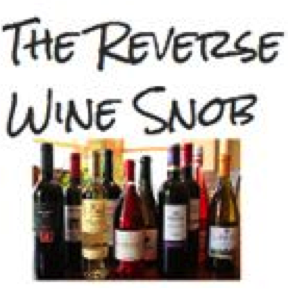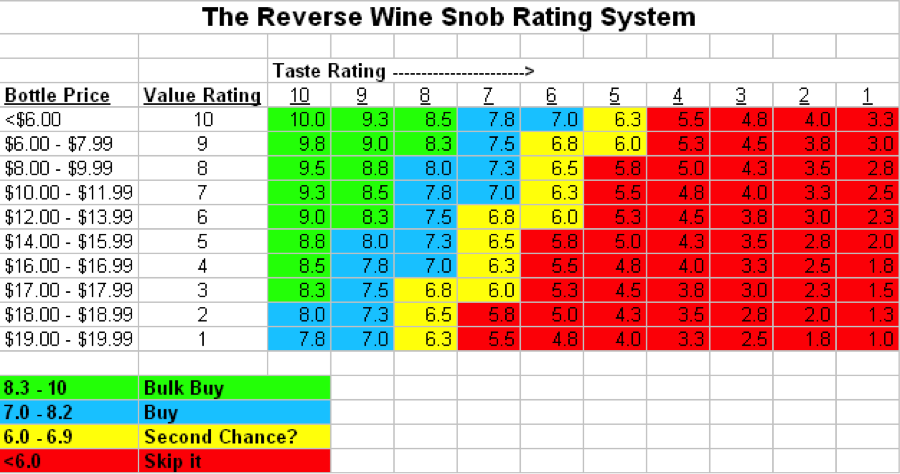
Today we wish to feature an interesting and valuable wine blog, The Reverse Wine Snob, (www.reversewinesnob.com) updated quite frequently by Jon Thorsen, located in our former home state of Minnesota. (Yes, they do have very long winters and chilly springs up north, but those former Nordics purchase and drink a lot of wine, partly as a result of being indoors much of the year.) Jon’s subscribers are largely wine drinkers who want the greatest wine quality for the lowest prices, starting with the cost of subscription to his service, which is ZERO. For those of us who years ago had a smattering of economics/price theory, we understand it is impossible to solve this equation (as quality and price are both variables), but Jon does a decent balancing job: he rates wines he reviews for both quality and price, comes up with a final score, and then makes consumer suggestions to purchase, purchase in quantity, or “Saturday Night Splurge” for the highest quality, and forget the price once a week. (We like this approach!)
We think his wine blog is quite valuable for many, especially for those considering purchase of imported wine in the $12-$22 range with which they have no prior experience. Many in the wine business are regular readers as it is a very interesting approach, especially as most wine buyers are far more price sensitive than the wine business likes to discuss publicly. The average retail price of a bottle of wine in the US is around $6.25, and perhaps 80% of the wine is sold for less than $10/bottle. As growers of premium grapes in Napa, Sonoma, and South Africa, we are not very interested in the sub $10 market, but even the occasional sub $10 reviewed by Jon can be rated quite highly for low prices, hence his “Reverse Wine Snob” blog name, and his Bulk Buy category. But if the wine quality is only so-so, his overall rating is usually under about 7.3, perhaps his median score for wines reviewed on his site. (Lower quality wines are usually not reviewed.)
Because the wine business ultimately is a business, and at a minimum each participant must recover their costs (or permanently subsidize a very expensive hobby, which clearly a number do), we thought a thorough discussion of wine economics may prove interesting to some. We will leave that exercise for a later day, however, and just supply some conclusions based on our own experience.
Supply chain economics/observations:
- Your retail $15/bottle of imported wine contains at most wine costing $1-$1.50 (10% at most) at the winery level, and frequently less than $1 (6% of the retail price per bottle). We hope the consumers do not begrudge the growers/wine makers this pittance of total wine bottle cost. Packaging at least triples the winery cost to somewhere between $3 and $5, FOB some major port.
- The wine sold by the foreign winery for $5 then sees the cost at least tripled again to $15 if not $17 or more at the US retail store. (As there are thousands of wineries competing to get into the US wine market, and only about 300 significant distributors, and perhaps 30 major ones, the distributors and retailers are able to compete imported supply prices to the lowest possible levels.)
- Most imported wine sold for $10/bottle or less is pretty much a “semi-industrial grade” product; and when you get down to $4.99 to $6.99 wine, wine reviews are irrelevant! (It may be red, 14% alcohol, and in a 750ml bottle, but that’s about it.) Admittedly, it is far better wine than available 20-30 years ago at these prices, but usually not very remarkable.
- We see little high quality imported wine selling for much below $12-$15/bottle for these reasons; and since there is real consumer resistance to experimenting much above $20/bottle, it appears that most of the imported retail game will likely be played in this range for the next several years.
- As more Internet-hip Millenials on limited budgets take up wine drinking, blogs such as Jon Thorsen’s will become increasingly popular. And while imported wine today in the US is about 33% of total wine sales, many have projected imported wines taking at least 50% of the US wine market within another 15 years. If so, blog-informed consumers will become increasingly happier with having taken the time in advance to sort the wheat from the chaff.


Thanks Dave, a very informative article!
– Jon Thorsen